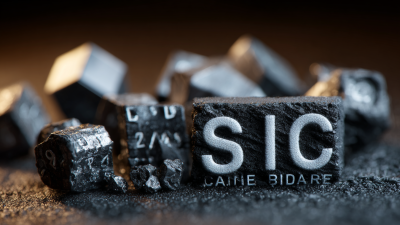Leave Your Message
In the rapidly evolving world of semiconductor materials, Sic Silicon Carbide is poised to drive significant advancements in performance and efficiency by 2025. As industries increasingly embrace sustainable technologies and high-performance solutions, the relevance of Sic Silicon Carbide continues to grow. Dr. Emily Chen, a renowned expert in semiconductor materials, emphasizes the importance of this material by stating, "Sic Silicon Carbide is not just a revolutionary compound; it is the backbone of future energy-efficient technologies."

The superior thermal conductivity and electric field strength of Sic Silicon Carbide make it an ideal candidate for a variety of applications, ranging from electric vehicles to renewable energy systems. As we look toward 2025, the integration of Sic Silicon Carbide into power electronics and high-temperature devices promises to enhance performance while reducing overall energy consumption. The potential for Sic Silicon Carbide to transform industries is immense, marking a pivotal shift towards more sustainable operational practices.
With the advent of new manufacturing techniques and a growing understanding of Sic Silicon Carbide's unique properties, stakeholders must explore how to leverage this material effectively. The coming years will be critical as we navigate the challenges and opportunities presented by Sic Silicon Carbide, ultimately aiming to set the standard for innovation and performance across multiple sectors.
Silicon carbide (SiC) is rapidly becoming a critical material for modern applications due to its unique properties that enhance performance across various industries. One of the key advantages of SiC is its exceptional thermal conductivity, which allows for efficient heat dissipation in high-power electronic devices. This characteristic is particularly beneficial in sectors such as electric vehicles and renewable energy, where managing heat is crucial for maintaining performance and prolonging component lifespan.
Another significant benefit of SiC is its high breakdown voltage and electric field strength, enabling the design of smaller and more efficient power devices. This capability leads to a reduction in overall system size and weight, making SiC an ideal choice for aerospace and automotive applications. Furthermore, SiC's chemical stability and resistance to wear and corrosion ensure reliability and durability, even in harsh environments, further solidifying its role as a game-changer in modern technology. As we look towards 2025, leveraging these advantages will be essential for optimizing system performance and achieving sustainability goals in various fields.

In 2025, the implementation of Silicon Carbide (SiC) technology is set to transform various sectors, particularly in power electronics and electric vehicles. The Singapore Agency for Science, Technology and Research (A*STAR) has made a significant stride by launching the world's first 200mm industrial-grade open R&D SiC production line. This initiative is part of a broader effort to enhance semiconductor capabilities, aligning with a market trend that anticipates the Silicon Carbide coating market will expand from USD 506.3 million in 2025 to approximately USD 1.64 billion by 2030, reflecting a growing demand for efficient, high-performance materials in power systems.
Innovative techniques in SiC applications promise not only improved performance but also sustainability in energy distribution. Notably, advancements such as the new SiC technology introduced by companies like Infineon are expected to facilitate smarter and faster power distribution solutions. Additionally, with Wolfspeed developing 1200V SiC modules that can boost inverter current by 15% while significantly reducing thermal resistance, the push towards more efficient power management is evident. As industries adopt these revolutionary techniques, they will be better equipped to meet the energy demands of the future while minimizing environmental impact.
Silicon carbide (SiC) has emerged as a pivotal material in various industries due to its superior performance metrics compared to traditional silicon. Evaluating the efficiency of SiC involves several critical metrics including thermal conductivity, breakdown voltage, and switching speed. These properties contribute to enhanced performance in applications such as power electronics, electric vehicles, and renewable energy systems. The remarkable thermal conductivity of SiC allows devices to operate at higher temperatures, resulting in improved reliability and reduced cooling requirements.
In addition to thermal performance, the breakdown voltage of SiC is significantly greater than that of silicon, enabling higher voltage operations and reducing the size and weight of components. This is particularly beneficial in high-power applications where efficiency is paramount. Furthermore, the rapid switching capabilities of SiC devices lead to lower energy losses during operation, which is a crucial aspect for enhancing overall system efficiency. By focusing on these performance metrics, industries can fully leverage the advantages of SiC, thereby ensuring that advancements in technology align with the growing demand for energy efficiency and sustainability in 2025 and beyond.
| Metric | Value | Unit | Notes |
|---|---|---|---|
| Thermal Conductivity | 150 | W/m·K | Higher than traditional materials |
| Bandgap | 3.0 | eV | Suitable for high-efficiency devices |
| Breakdown Voltage | 3,000 | V | Allows for higher power applications |
| Efficiency | 98% | % | Comparative advantage in energy savings |
| Operating Temperature | 200 | °C | Higher than silicon |
The recent launch of Singapore's new eight-inch SiC production line represents a significant advancement in the capabilities of silicon carbide technology, paving the way for its expanded use in emerging applications. As the semiconductor industry shifts towards larger wafer sizes for increased efficiency, the introduction of the world's first 200mm industrial-grade SiC line is set to revolutionize the production of high-performance electronic devices. According to a recent market report, the silicon carbide market is projected to reach USD 2.4 billion by 2025, driven by the demand from electric vehicles and renewable energy sectors, highlighting the critical role SiC plays in future technologies.
With SiC's excellent thermal conductivity, high breakdown electric field, and superior switching capabilities, its application in power electronics is foreseen to increase significantly. Industry experts note that SiC devices can operate at higher temperatures (up to 200°C) and voltages, improving energy efficiency and reducing system size. This makes them especially attractive for applications in electric vehicles, where efficiency and performance are paramount. As companies ramp up their investment in SiC technology, Singapore's initiative not only strengthens its position in the global semiconductor landscape but also aligns with projected trends indicating a shift to wide-bandgap semiconductors as the catalyst for next-generation technology advancements.
Silicon Carbide (SiC) has emerged as a critical element for enhancing industrial performance, particularly in the electric vehicle (EV) sector. With the global SiC devices market projected to grow from $3.21 billion in 2024 to $21.27 billion by 2032, a staggering CAGR of 26.7%, it is clear that industries are increasingly recognizing its value. This growth is primarily driven by the demand for improved power electronics and efficiency in greener transport solutions. In particular, advancements in SiC wafer technology are enhancing EV battery efficiency, potentially allowing vehicles to travel 20% farther on a single charge.

Case studies show that companies within this sphere are adopting SiC technology at an unprecedented rate. The SiC wafer reclaim market is estimated to reach USD 2 billion by 2036, indicating a robust interest in sustainability and performance optimization. As industries adapt to rapid changes in market dynamics, the effective management of SiC supply and demand is crucial for manufacturers seeking to maintain a competitive edge.
Tips for Implementation:






